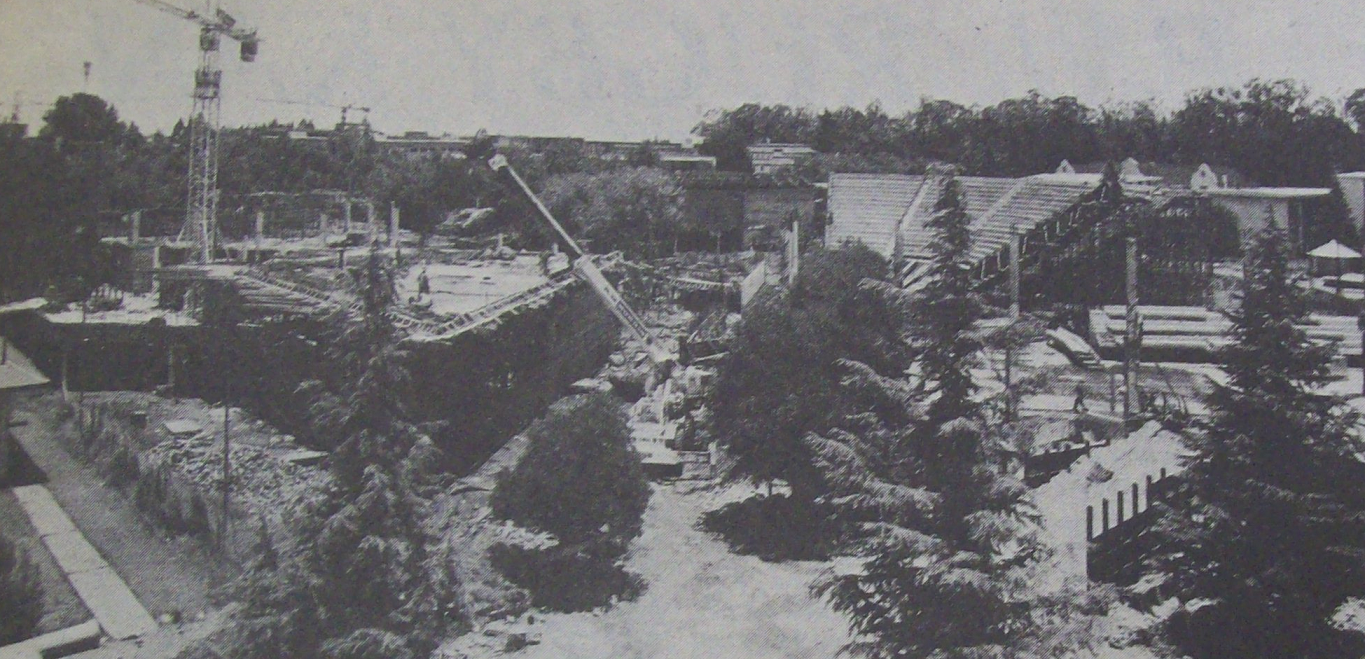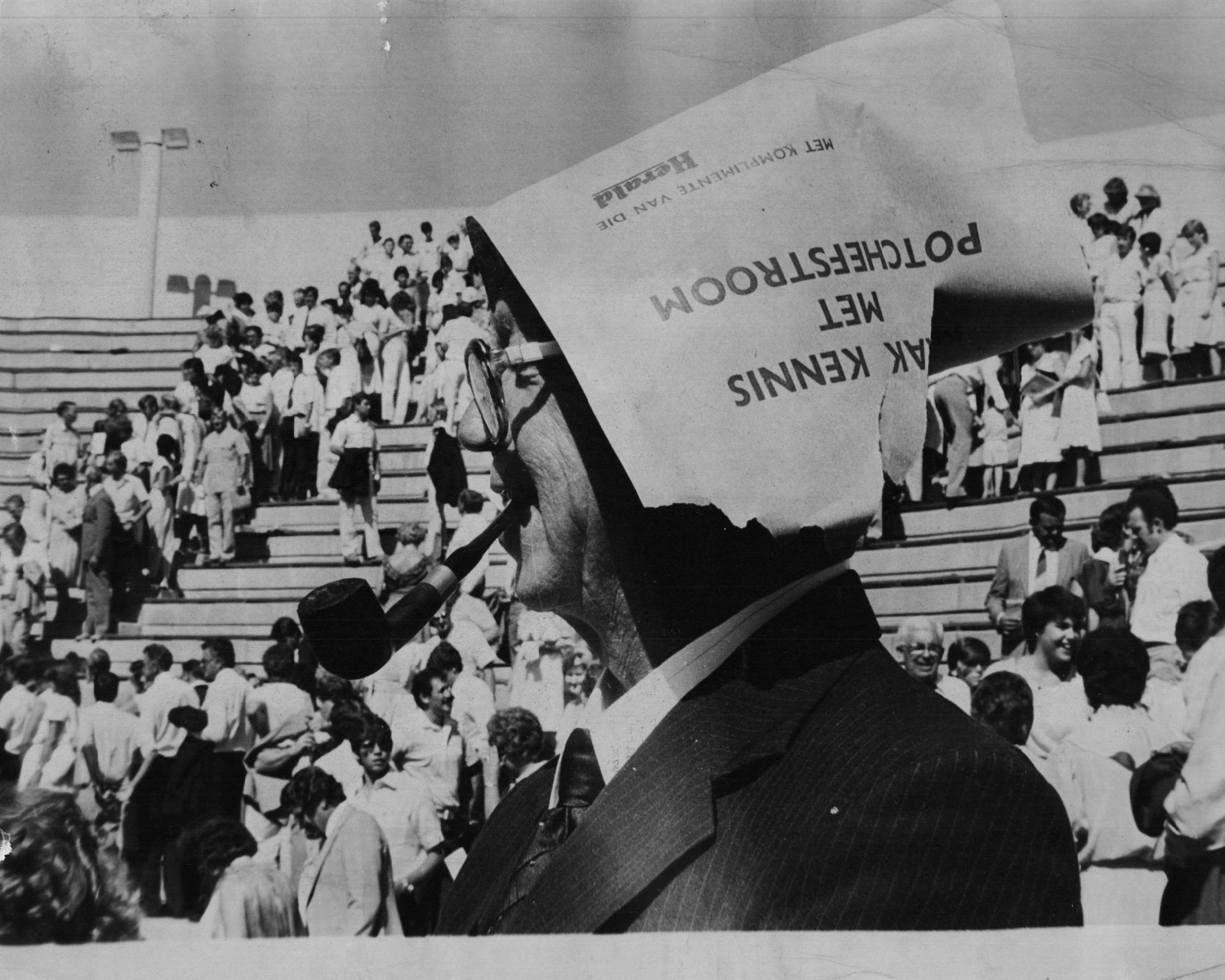Amphitheatre
Amphitheatre today
- Bannie Britz, one of the collaborating architects of the Student Centre, wrote this description of architectural objectives and style of the Student Centre. It was included in the programme of the inauguration of the Hennie Bingle Student Centre in 1980
Ten years ago planning the Student Centre commenced. It was at a time of worldwide student unrest. The then rector, Professor Bingle, gave the instructions that the complex must be built in such a manner so that students feel at home on the campus. He wanted a building with a specific simplicity and robustness to give expression of specific characteristics of the Afrikaner. The complex should consist of an auditorium, committee rooms, offices, a council chamber for students and the Students’ Representative Council, a large comprehensive indoor sport centre, cafeteria with lounges and a large open-air amphitheatre.
The placement of the complex on the campus was done by Mr Wilhelm Meyer, the university architect, who was also appointed to the project.
The architects realised that this building complex contained unique possibilities and decided to do more than to provide the requested facilities in a purposeful way. The following objectives were pursued:
- The complex had to be an educational instrument. Currently comprehensive urbanisation is taking place.
- The area had to stimulate towards creative and active use of time, by making people aware of the wide range of activities that the city in our time provides.
- It should be an area where young people would feel at home. Use of colour should be an important means to stimulate youthful joie de vivre.
- A first local prototype of a type of complex which – especially in Europe became increasingly popular – was planned. The function of a general gathering place, which for example was fulfilled by the Greek Agora or the medieval town square, is missing in the modern city. Modern means of travel and communication are tearing the city, and with that the community, apart. Multi-purpose community centres, that are built more and more, serve as focal points in many cities. A point of equilibrium in the university, was sought, which at the same time draw people from inside and outside, like a magnet, to thus effect interaction.
- The placing of the buildings on the current centre of gravity of the campus, over the main routes of movement of the students was fortunate. This led to the simple concept of a courtyard, coupled to the amphitheatre. With its fountain, seats and trees it was to become a meeting and rubbing place. The internal circulation is structured around an internal ring street on the level of the first storey. The short period of time it would take you to walk around this street should expose you to manifold activities and hopefully encourage you to become a participant. The street hence became an important means of communication.
- The architectural language is simple. A ‘landscape’ in which more people would be aware of spaces, places and their activities, as well as the drama of interaction of the encircled elements such as facades, was consciously sought. The floor of the complex, with its up and down movements, steps and ramps was to be the most important façade of the building and is emphasised with miscellaneous patterns. All possible trees were kept and supplemented to contribute to the fusion of the borders between architecture and landscape. It was endeavoured to create a place where urban environment, art landscape and architecture unselfconsciously work together rather than to plant an interesting but strange object in the fabric of the university.
- Time will tell if this experiment will contribute a meaningful dimension to the university life.

This architect’s drawing of the Student Centre was published in the PU-Kaner on 9 August 1974. It shows (1) the hall (auditorium) (2) roof garden (which was later changed)
(3) cafeteria and lounges (4) indoor sports venue and sports rooms (5) amphitheatre
(6) courtyard and fountain (the latter does not exist anymore) (7) offices of the Students’ Representative Council and (8) one of the walkways (today known as Lovers Lane).

. Wapad published this photo of the Student Centre under construction.
In front is the cafeteria and lounges block and in the upper right a part of the Amphitheatre can be identified.
- The Amphitheatre with seating for 3 500 was inaugurated in 1980 and was meant to be used for large gatherings, student meetings, open air concerts and sporting activities.
- Initially the concrete seats were covered with wood, but that was later removed. From the word go it was realised that if the Amphitheatre had a roof, it could be used more.
- In 2006 it was announced that the plans to put a roof on the Amphitheatre were going ahead. The first phase was completed in 2007, during which the half circle of seats on the eastern side of the Amphitheatre and the offices of the town residences, under these seats, were demolished.
- The second phase took much longer. Initially it was considered to put up a roof made from synthetic canvas, but this did not comply with the standards that were set. After it was decided to construct the roof as it is now, the project was further delayed when steel for the pillars was unavailable.
- It was hoped that the roof would be ready for the reception of the first years at the beginning of 2008, but the project was only completed later that year.

Photo: After the new Student Centre had come into operation in July 1979, the first Big Brag,
just before Intervarsity in August that year, was held in the Amphitheatre.

Rev AMJ van Vuuren made himself a hat from the cover of a complimentary edition of the Herald, the community paper of Potchefstroom.
This photo appeared in the Potchefstroom Herald on 31 January 1984..


